The Use of Envi-Met for the Assessment of Nature-Based Solutions’ Potential Benefits in Industrial Parks—A Case Study of Argales Industrial Park (Valladolid, Spain)
Abstract
:1. Introduction
2. Materials and Methods
2.1. Study Area
2.2. Location of the Study Area
2.3. Modeling
2.4. Microclimatic Computer Simulation
2.5. Model Input Data
3. Results and Discussion
3.1. Microclimate Data Validation
3.1.1. Air Temperature
3.1.2. Relative Humidity
3.1.3. Wind Speed
3.1.4. Mean Radiant Temperature
3.2. Scenarios
3.2.1. Air Temperature
3.2.2. Wind Speed
3.2.3. Mean Radiant Temperature
3.3. Comparison between Scenarios
3.3.1. Air Temperature
3.3.2. Mean Radiant Temperature
4. Limitations
5. Conclusions
Author Contributions
Funding
Institutional Review Board Statement
Informed Consent Statement
Data Availability Statement
Acknowledgments
Conflicts of Interest
Appendix A
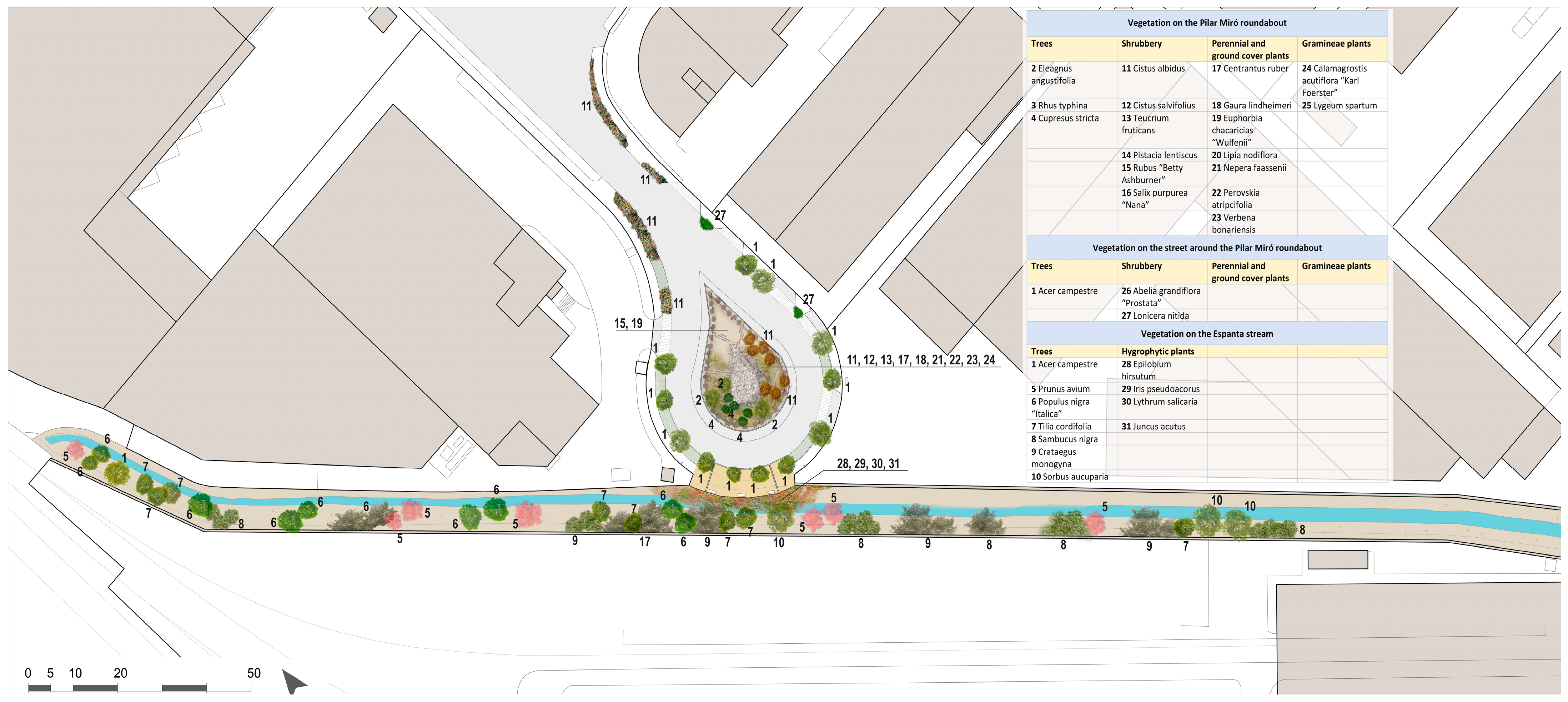
References
- Tourinho, L.; Prevedello, J.A.; Carvalho, B.M.; Rocha, D.S.B.; Vale, M.M. Macroscale Climate Change Predictions Have Little Influence on Landscape-Scale Habitat Suitability. Perspect. Ecol. Conserv. 2022, 20, 29–37. [Google Scholar] [CrossRef]
- Mehryar, S.; Sasson, I.; Surminski, S. Supporting Urban Adaptation to Climate Change: What Role Can Resilience Measurement Tools Play? Urban Clim. 2022, 41, 101047. [Google Scholar] [CrossRef]
- Shi, C.; Guo, N.; Zeng, L.; Wu, F. How Climate Change Is Going to Affect Urban Livability in China. Clim. Serv. 2022, 26, 100284. [Google Scholar] [CrossRef]
- Ray Biswas, R.; Sharma, R.; Gyasi-Agyei, Y. Urban Water Crises: Making Sense of Climate Change Adaptation Barriers and Success Parameters. Clim. Serv. 2022, 27, 100302. [Google Scholar] [CrossRef]
- Ribeiro, H.; Pesquero, C.R.; De Sousa Zanotti Stagliorio Coelho, M. Clima Urbano e Saúde: Uma Revisão Sistematizada Da Literatura Recente. Estud. Av. 2016, 30, 67–82. [Google Scholar] [CrossRef] [Green Version]
- Oke, T.R.; Mills, G.; Christen, A.; Voogt, J.A. Urban Climates, 1st ed.; Sheridan Books, Inc.: Cambridge, UK, 2017; ISBN 9781139016476. [Google Scholar]
- Stewart, I.D.; Oke, T.R. Local Climate Zones for Urban Temperature Studies. Bull. Am. Meteorol. Soc. 2012, 93, 1879–1900. [Google Scholar] [CrossRef]
- Landsberg, H. The Urban Climate; Academic Press: Cambridge, MA, USA, 1981; Volume 53, ISBN 9788578110796. [Google Scholar]
- Iain Stewart, G.M. The Urban Heat Island, 1st ed.; Elsevier: Amsterdam, The Netherlands, 2021; ISBN 9780128150177. [Google Scholar]
- Oke, T.R. Boundary Layer Climates, 2nd ed.; Routledge: London, UK, 2002. [Google Scholar]
- Gonçalves, A.; Ornellas, G.; Ribeiro, A.C.; Maia, F.; Rocha, A.; Feliciano, M. Urban Cold and Heat Island in the City of Bragança (Portugal). Climate 2018, 6, 70. [Google Scholar] [CrossRef] [Green Version]
- Vahmani, P.; Luo, X.; Jones, A.; Hong, T. Anthropogenic Heating of the Urban Environment: An Investigation of Feedback Dynamics between Urban Micro-Climate and Decomposed Anthropogenic Heating from Buildings. Build. Environ. 2022, 213, 108841. [Google Scholar] [CrossRef]
- Gettelman, A.; Rood, R.B. Demystifying Climate Models: A Users Guide to Earth System Models; Springer: Berlin/Heidelberg, Germany, 2016; Volume 2, ISBN 9783662489574. [Google Scholar]
- Liu, M.; Lo, K. A Comparative Review of Urban Climate Governance in Chinese and Western Contexts. Urban Gov. 2021; in press. [Google Scholar] [CrossRef]
- Crank, P.J.; Sailor, D.J.; Ban-Weiss, G.; Taleghani, M. Evaluating the ENVI-Met Microscale Model for Suitability in Analysis of Targeted Urban Heat Mitigation Strategies. Urban Clim. 2018, 26, 188–197. [Google Scholar] [CrossRef]
- Raymond, C.M.; Frantzeskaki, N.; Kabisch, N.; Berry, P.; Breil, M.; Nita, M.R.; Geneletti, D.; Calfapietra, C. A Framework for Assessing and Implementing the Co-Benefits of Nature-Based Solutions in Urban Areas. Environ. Sci. Policy 2017, 77, 15–24. [Google Scholar] [CrossRef]
- European Commission. Towards an EU Research and Innovation Policy Agenda for Nature-Based Solutions & Re-Naturing Cities: Final Report of the Horizon 2020 Expert Group on “Nature-Based Solutions and Re-Naturing Cities”; European Commission: Brussels, Belgium, 2015; ISBN 9789279460517. [Google Scholar]
- Toxopeus, H.; Kotsila, P.; Conde, M.; Katona, A.; van der Jagt, A.P.N.; Polzin, F. How ‘Just’ Is Hybrid Governance of Urban Nature-Based Solutions? Cities 2020, 105, 102839. [Google Scholar] [CrossRef]
- Faivre, N.; Fritz, M.; Freitas, T.; de Boissezon, B.; Vandewoestijne, S. Nature-Based Solutions in the EU: Innovating with Nature to Address Social, Economic and Environmental Challenges. Environ. Res. 2017, 159, 509–518. [Google Scholar] [CrossRef]
- Devecchi, A.M.; Chirmici, A.C.; Simonetti, C.; Thiago, B.C. Desenhando Cidades Com Soluções Baseadas Na Natureza. In Parcerias Estratégicas; CGEE: Brasilia, Brasil, 2020; pp. 217–233. ISBN 1413-9375. [Google Scholar]
- Kabisch, N.; Frantzeskaki, N.; Pauleit, S.; Naumann, S.; Davis, M.; Artmann, M.; Haase, D.; Knapp, S.; Korn, H.; Stadler, J.; et al. Nature-Based Solutions to Climate Change Mitigation and Adaptation in Urban Areas: Perspectives on Indicators, Knowledge Gaps, Barriers, and Opportunities for Action. Ecol. Soc. 2016, 21, 39. [Google Scholar] [CrossRef] [Green Version]
- European Commission. Evaluating the Impact of Nature-Based Solutions: A Handbook for Practitioners; Dumitru, A., Wendling, L., Eds.; European Commission: Brussels, Belgium, 2021; ISBN 9789276229612. [Google Scholar]
- Frantzeskaki, N. Seven Lessons for Planning Nature-Based Solutions in Cities. Environ. Sci. Policy 2019, 93, 101–111. [Google Scholar] [CrossRef]
- Ávila, L.B. Instrumento Multicritério de Análise Para a Implantação de Zonas Industriais: Variáveis Legais, Antrópicas e Naturais. 2018. Available online: http://www.repositorio.jesuita.org.br/handle/UNISINOS/7088 (accessed on 15 April 2022).
- Presumido, P.H.; Gonçalves, A.; Feliciano, M.; Igrejas, G.; Romero, F. Projeto Rehabind-Qualidade Ambiental Em Áreas Industriais Transfronteiriças-Mirandela e Zamora (Espanha). In Livro de Atas da Conferência Internacional de Ambiente em Língua Portuguesa, Avaito, Poretugal, 8–10 May 2018; Universidade de Aveiro: Aveiro, Portugal, 2018; pp. 21–24. ISBN 978-972-789-540-3. [Google Scholar]
- González, J.E.; Ramamurthy, P.; Bornstein, R.D.; Chen, F.; Bou-Zeid, E.R.; Ghandehari, M.; Luvall, J.; Mitra, C.; Niyogi, D. Urban Climate and Resiliency: A Synthesis Report of State of the Art and Future Research Directions. Urban Clim. 2021, 38, 100858. [Google Scholar] [CrossRef]
- Geophysical Fluid Dynamics Laboratory. Climate Modeling.
- Gusson, C.S.; Duarte, D.H.S. Effects of Built Density and Urban Morphology on Urban Microclimate—Calibration of the Model ENVI-Met V4 for the Subtropical Sao Paulo, Brazil. Procedia Eng. 2016, 169, 2–10. [Google Scholar] [CrossRef]
- Daniela Bruse, Michael Bruse, Helge Simon ENVI_MET GmbH 2020.
- Middel, A.; Häb, K.; Brazel, A.J.; Martin, C.A.; Guhathakurta, S. Impact of Urban Form and Design on Mid-Afternoon Microclimate in Phoenix Local Climate Zones. Landsc. Urban Plan. 2014, 122, 16–28. [Google Scholar] [CrossRef]
- Bruse, M.; Fleer, H. Simulating Surface-Plant-Air Interactions inside Urban Environments with a Three Dimensional Numerical Model. Environ. Model. Softw. 1998, 13, 373–384. [Google Scholar] [CrossRef]
- Bruse, M. ENVI-Met 3.0: Updated Model Overview; University of Bochum: Bochum, Germany, 2004; pp. 1–12. [Google Scholar]
- Duarte, D.H.S.; Shinzato, P.; dos Santos Gusson, C.; Alves, C.A. The Impact of Vegetation on Urban Microclimate to Counterbalance Built Density in a Subtropical Changing Climate. Urban Clim. 2015, 14, 224–239. [Google Scholar] [CrossRef]
- McRae, I.; Freedman, F.; Rivera, A.; Li, X.; Dou, J.; Cruz, I.; Ren, C.; Dronova, I.; Fraker, H.; Bornstein, R. Integration of the WUDAPT, WRF, and ENVI-Met Models to Simulate Extreme Daytime Temperature Mitigation Strategies in San Jose, California. Build. Environ. 2020, 184, 107180. [Google Scholar] [CrossRef]
- Cárdenas Celis, A.M.; Silva, C.F. Protocolo de Elaboração de Arquivo Climático de Cidades Brasileiras Para o Software ENVI-Met 4.0. Paranoá Cad. Arquitetura Urban. 2018, 22, 32–50. [Google Scholar] [CrossRef]
- Ali-Toudert, F. Exploration of the Thermal Behaviour and Energy Balance of Urban Canyons in Relation to Their Geometrical and Constructive Properties. Build. Environ. 2021, 188, 107466. [Google Scholar] [CrossRef]
- Ali-Toudert, F.; Mayer, H. Numerical Study on the Effects of Aspect Ratio and Orientation of an Urban Street Canyon on Outdoor Thermal Comfort in Hot and Dry Climate. Build. Environ. 2006, 41, 94–108. [Google Scholar] [CrossRef]
- Aslam, A.; Rana, I.A. The Use of Local Climate Zones in the Urban Environment: A Systematic Review of Data Sources, Methods, and Themes. Urban Clim. 2022, 42, 101120. [Google Scholar] [CrossRef]
- Tsoka, S.; Tsikaloudaki, A.; Theodosiou, T. Analyzing the ENVI-Met Microclimate Model’s Performance and Assessing Cool Materials and Urban Vegetation Applications–A Review. Sustain. Cities Soc. 2018, 43, 55–76. [Google Scholar] [CrossRef]
- Salata, F.; Golasi, I.; Petitti, D.; de Lieto Vollaro, E.; Coppi, M.; de Lieto Vollaro, A. Relating Microclimate, Human Thermal Comfort and Health during Heat Waves: An Analysis of Heat Island Mitigation Strategies through a Case Study in an Urban Outdoor Environment. Sustain. Cities Soc. 2017, 30, 79–96. [Google Scholar] [CrossRef]
- Maleki, A.; Mahdavi, A.; Design, U. Evaluation of Urban Heat Islands Mitigation Strategies using 3dimentional Urban Micro-climate Model Envi-Met. Asian J. Civ. Eng. 2016, 17, 357–371. [Google Scholar]
- Evola, G.; Gagliano, A.; Fichera, A.; Marletta, L.; Martinico, F.; Nocera, F.; Pagano, A. UHI Effects and Strategies to Improve Outdoor Thermal Comfort in Dense and Old Neighbourhoods. Energy Procedia 2017, 134, 692–701. [Google Scholar] [CrossRef]
- Tsilini, V.; Papantoniou, S.; Kolokotsa, D.D.; Maria, E.A. Urban Gardens as a Solution to Energy Poverty and Urban Heat Island. Sustain. Cities Soc. 2015, 14, 323–333. [Google Scholar] [CrossRef]
- Morakinyo, T.E.; Lam, Y.F. Simulation Study on the Impact of Tree-Configuration, Planting Pattern and Wind Condition on Street-Canyon’s Micro-Climate and Thermal Comfort. Build. Environ. 2016, 103, 262–275. [Google Scholar] [CrossRef]
- Lobaccaro, G.; Acero, J.A. Comparative Analysis of Green Actions to Improve Outdoor Thermal Comfort inside Typical Urban Street Canyons. Urban Clim. 2015, 14, 251–267. [Google Scholar] [CrossRef]
- CENIE Centro Internacional Sobre o Envelhecimento (CENIE)—Instituto Nacional de Estadística. Available online: https://cenie.eu/pt/observatorio/demografia/valladolid (accessed on 10 May 2022).
- Instituto Nacional de Estadística (INE) Cifras de Población. Available online: https://www.valladolid.es/es/ciudad/estadisticas/utilidad/servicios/observatorio-urbano-datos-estadisticos-ciudad/datos-estadisticos-temas/informacion-estadistica-ciudad/poblacion/cifras-poblacion (accessed on 13 May 2021).
- Propuesta de Orden de la Consejería de Empleo e Industria por la Que Se Aprueba el Programa Territorial de Fomento para Medina del Campo y Su Entorno 2021–2024. Available online: https://transparencia.jcyl.es/participacion/Participaci%C3%B3n%20Empleo%20e%20Industria/2021-10-21%20Propuesta%20Orden%20PTF%20MEDINA%20DEL%20CAMPO%20v4.pdf (accessed on 15 February 2022).
- De Souza, V.S. Mapa Climático Urbano Da Cidade De João Pessoa-Pb. In Encontro Latino-Americano de Conforto no Ambiente Construído; Federal University of Paraíba: João Pessoa, Brazil, 2019. [Google Scholar]
- Simon, H.; Kissel, L.; Bruse, M. Evaluation of ENVI-Met’s Multiple-Node Model and Estimation of Indoor Climate. In Proceedings of the PLEA, Edinburgh, UK, 2–5 July 2017; Volume 2, pp. 2173–2180. [Google Scholar]
- E Silva, C.F.; Romero, M.A.B. Simulação do Clima Urbano do Distrito Federal: Experimentando o ENVI-Met; Editora da Universidade de Brasília: Brasília, Brasil, 2020. [Google Scholar]
- Oke, T.R. The Energetic Basis of the Urban Heat Island. Q. J. R. Meteorol. Soc. 1982, 108, 1–24. [Google Scholar] [CrossRef]
- Mohammad, P.; Aghlmand, S.; Fadaei, A.; Gachkar, S.; Gachkar, D.; Karimi, A. Evaluating the Role of the Albedo of Material and Vegetation Scenarios along the Urban Street Canyon for Improving Pedestrian Thermal Comfort Outdoors. Urban Clim. 2021, 40, 100993. [Google Scholar] [CrossRef]
- Acero, J.A.; Herranz-Puaascl, K. A Comparison of Thermal Comfort Conditions in Four Urban Spaces by Means of Measurements and Modelling Techniques. Build. Environ. 2015, 93, 245–257. [Google Scholar] [CrossRef]
- Ketterer, C.; Matzarakis, A. Human-Biometeorological Assessment of Heat Stress Reduction by Replanning Measures in Stuttgart, Germany. Landsc. Urban Plan. 2014, 122, 78–88. [Google Scholar] [CrossRef]
- Shinzato, P.; Simon, H.; Silva Duarte, D.H.; Bruse, M. Calibration Process and Parametrization of Tropical Plants Using ENVI-Met V4–Sao Paulo Case Study. Archit. Sci. Rev. 2019, 62, 112–125. [Google Scholar] [CrossRef]
- Ouyang, W.; Sinsel, T.; Simon, H.; Morakinyo, T.E.; Liu, H.; Ng, E. Evaluating the Thermal-Radiative Performance of ENVI-Met Model for Green Infrastructure Typologies: Experience from a Subtropical Climate. Build. Environ. 2022, 207, 108427. [Google Scholar] [CrossRef]
- Forouzandeh, A. Prediction of Surface Temperature of Building Surrounding Envelopes Using Holistic Microclimate ENVI-Met Model. Sustain. Cities Soc. 2021, 70, 102878. [Google Scholar] [CrossRef]
- Nasrollahi, N.; Hatami, Z.; Taleghani, M. Development of Outdoor Thermal Comfort Model for Tourists in Urban Historical Areas; A Case Study in Isfahan. Build. Environ. 2017, 125, 356–372. [Google Scholar] [CrossRef]
- Acero, J.A.; Arrizabalaga, J. Evaluating the Performance of ENVI-Met Model in Diurnal Cycles for Different Meteorological Conditions. Theor. Appl. Climatol. 2018, 131, 455–469. [Google Scholar] [CrossRef]
- Salata, F.; Golasi, I.; de Lieto Vollaro, R.; de Lieto Vollaro, A. Urban Microclimate and Outdoor Thermal Comfort. A Proper Procedure to Fit ENVI-Met Simulation Outputs to Experimental Data. Sustain. Cities Soc. 2016, 26, 318–343. [Google Scholar] [CrossRef]
- Perini, K.; Chokhachian, A.; Dong, S.; Auer, T. Modeling and Simulating Urban Outdoor Comfort: Coupling ENVI-Met and TRNSYS by Grasshopper. Energy Build. 2017, 152, 373–384. [Google Scholar] [CrossRef]
- Ali-Toudert, F.; Mayer, H. Thermal Comfort in an East-West Oriented Street Canyon in Freiburg (Germany) under Hot Summer Conditions. Theor. Appl. Climatol. 2007, 87, 223–237. [Google Scholar] [CrossRef]
- Lopez-Cabeza, V.P.; Alzate-Gaviria, S.; Diz-Mellado, E.; Rivera-Gomez, C.; Galan-Marin, C. Albedo Influence on the Microclimate and Thermal Comfort of Courtyards under Mediterranean Hot Summer Climate Conditions. Sustain. Cities Soc. 2022, 81, 103872. [Google Scholar] [CrossRef]
- Ferwati, S.; Skelhorn, C.; Ferwati, S.; Shandas, V.; Makido, Y. Urban Form and Variation in Temperatures. In Urban Adaptation to Climate Change; Springer: Berlin/Heidelberg, Germany, 2020. [Google Scholar]
- Ali-Toudert, F.; Mayer, H. Effects of Asymmetry, Galleries, Overhanging Façades and Vegetation on Thermal Comfort in Urban Street Canyons. Sol. Energy 2007, 81, 742–754. [Google Scholar] [CrossRef]
- Müller, N.; Kuttler, W.; Barlag, A.B. Counteracting Urban Climate Change: Adaptation Measures and Their Effect on Thermal Comfort. Theor. Appl. Climatol. 2014, 115, 243–257. [Google Scholar] [CrossRef] [Green Version]
- Huttner, S.; Bruse, M. Numerical Modeling of the Urban Climate—a Preview on ENVI-MET 4.0. In Proceedings of the 7th International Conference on Urban Climate ICUC-7, Yokohama, Japan, 29 June–3 July 2009; 2009; pp. 1–4. [Google Scholar]
- Lee, H.; Mayer, H.; Chen, L. Contribution of Trees and Grasslands to the Mitigation of Human Heat Stress in a Residential District of Freiburg, Southwest Germany. Landsc. Urban Plan. 2016, 148, 37–50. [Google Scholar] [CrossRef]

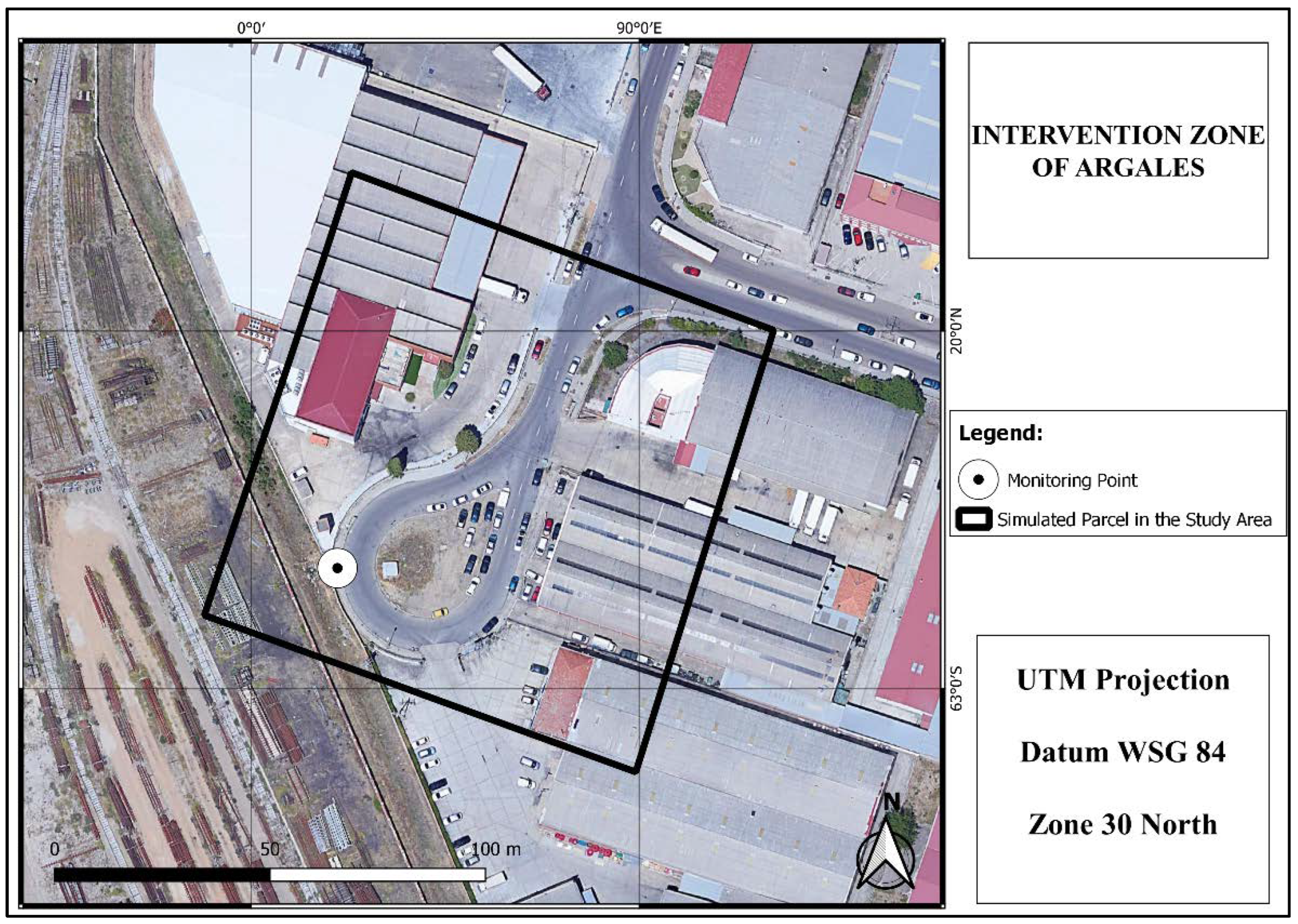


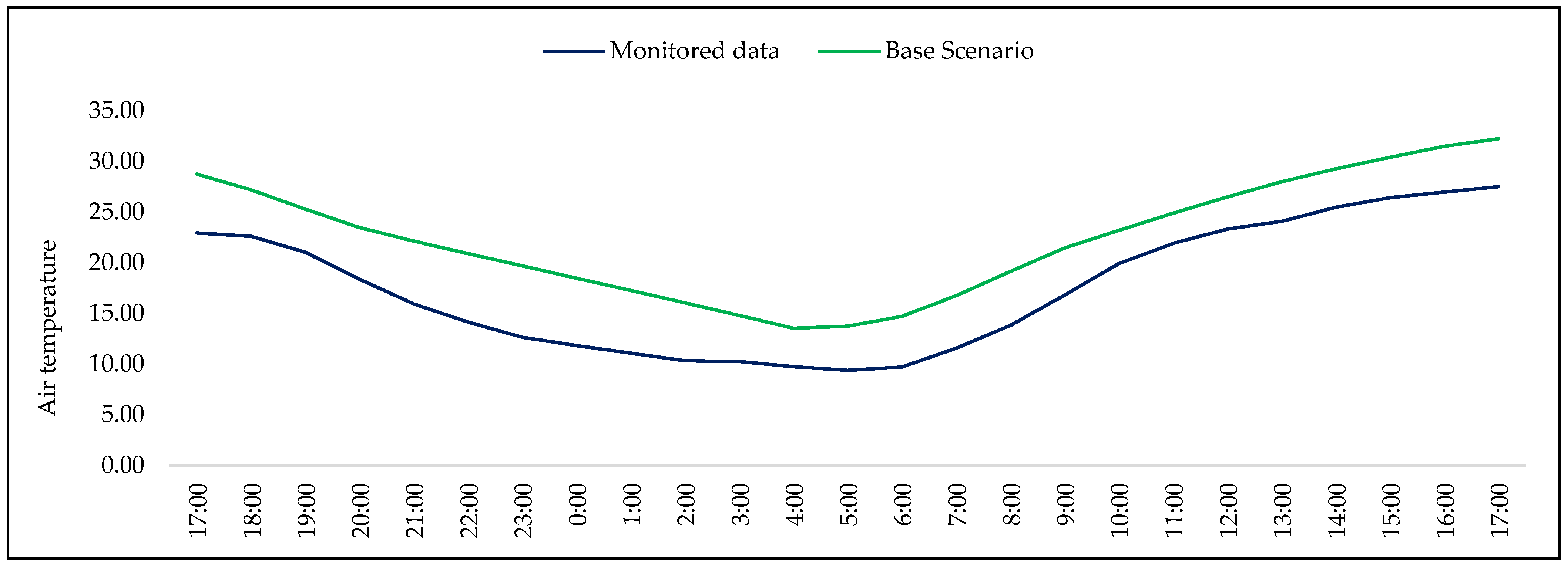

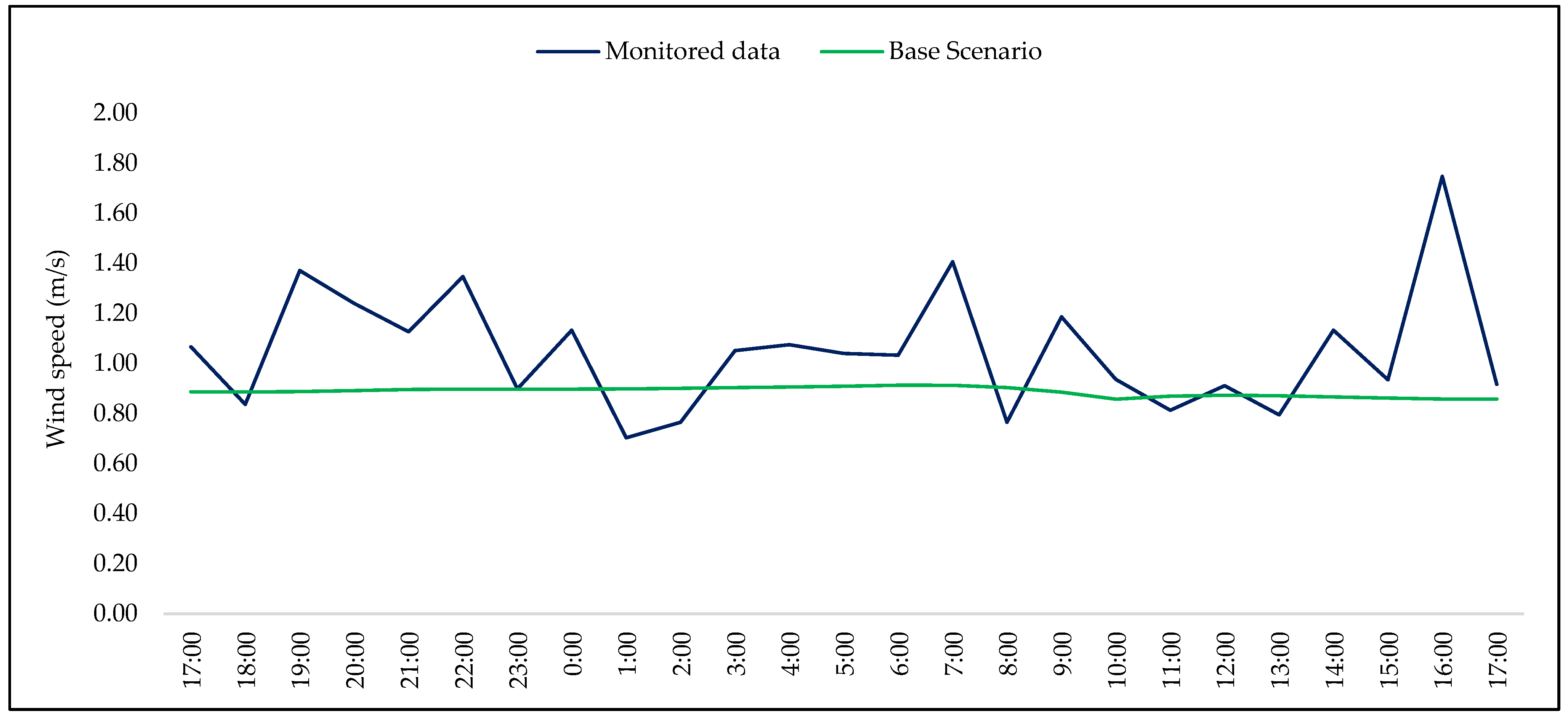
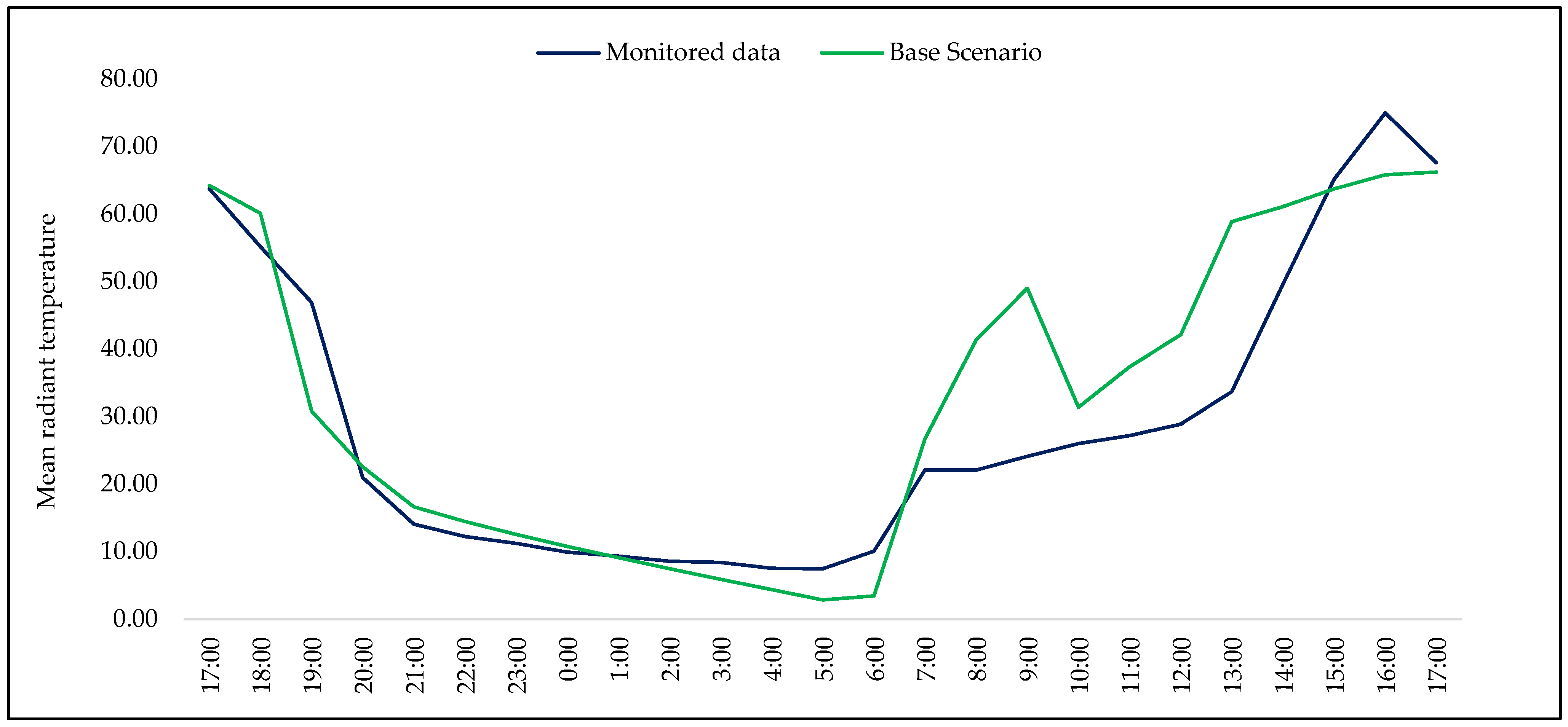







| Ta (°C) | RH (%) | WS (m/s) | WindDir (deg) | |
|---|---|---|---|---|
| Input Data | ||||
| Maximum | 27.60 | 88.53 | 1.4 | 121.5 |
| Minimum | 9.19 | 22.60 | ||
Publisher’s Note: MDPI stays neutral with regard to jurisdictional claims in published maps and institutional affiliations. |
© 2022 by the authors. Licensee MDPI, Basel, Switzerland. This article is an open access article distributed under the terms and conditions of the Creative Commons Attribution (CC BY) license (https://creativecommons.org/licenses/by/4.0/).
Share and Cite
Alves, F.M.; Gonçalves, A.; del Caz-Enjuto, M.R. The Use of Envi-Met for the Assessment of Nature-Based Solutions’ Potential Benefits in Industrial Parks—A Case Study of Argales Industrial Park (Valladolid, Spain). Infrastructures 2022, 7, 85. https://doi.org/10.3390/infrastructures7060085
Alves FM, Gonçalves A, del Caz-Enjuto MR. The Use of Envi-Met for the Assessment of Nature-Based Solutions’ Potential Benefits in Industrial Parks—A Case Study of Argales Industrial Park (Valladolid, Spain). Infrastructures. 2022; 7(6):85. https://doi.org/10.3390/infrastructures7060085
Chicago/Turabian StyleAlves, Felipe Macedo, Artur Gonçalves, and M. Rosario del Caz-Enjuto. 2022. "The Use of Envi-Met for the Assessment of Nature-Based Solutions’ Potential Benefits in Industrial Parks—A Case Study of Argales Industrial Park (Valladolid, Spain)" Infrastructures 7, no. 6: 85. https://doi.org/10.3390/infrastructures7060085






